originally posted at https://canmom.tumblr.com/post/713252...
Ahoy my friends! The hour is late, but not so late that we can’t watch a few films…
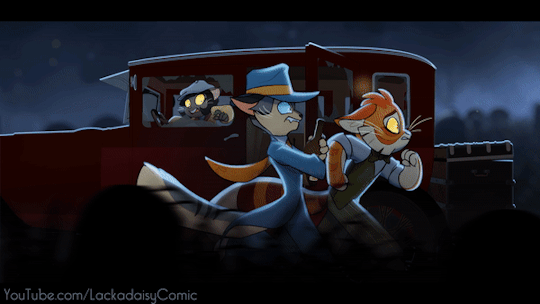
So. Lackadaisy huh.
I feel like you need to be in a somewhat specific age bracket of internet old to feel like that’s immensely significant. You need to be a webcomics bitch, basically. But from quite a specific era: the decade or so window between when webcomics looked like newspaper comics, and before the present era of webtoons. The Webcomics Review narrativises it as people who went to art school arriving on the scene in the mid-2000s, and that seems accurate enough. And of that crop, Lackadaisy Cats was certainly one of the biggest!
The concept is pretty straightforward. It’s a Prohibition-era crime drama set at a speakeasy that’s seen better days… and also everyone is an anthropomorphic cat. It was the beginning of the furry boom (Digger was a contemporary). But mostly… Tracy J. Butler could really fucking draw. You could say things like: clean, expressive designs with a lot of texture and depth and strong composition. (Not surprisingly, she’d worked in animation before drawing the comic.)
And compared to other comics whose selling point was the art such as The Meek and Dresden Codak, it also updated (if I’m remembering right) fairly consistently. It had archetypal characters, a very clearly defined aesthetic, and, compared to many webcomics of its era, a clear, accessible story. In short it read like a pro comic.
So it was natural for it to pick up steam.
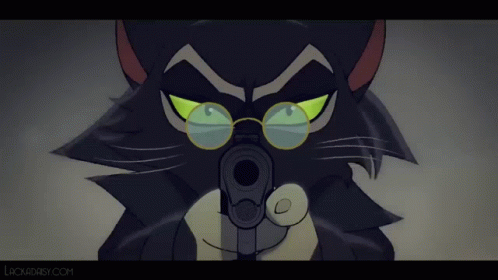
Now, at some point I kind of stopped keeping up with most of the webcomics I read back then. Sure, some of them stopped updating, but others kept on going, sustained on merch and later, Patreon type sites. In that time, the standard of art in the scene went way up, the number of comics became so huge that there was no longer really a ‘shared context’ of webcomic readers, and manga scans and webtoons arrived in force. It is now almost impossible to build a new following with a webcomic, but you can do pretty well for yourself if you got in at the start.
Well, in the last few years a new phenomenon has developed out of that whole webcomic scene: the crowdfunded independent animated film. I wrote about this a bit back on Animation Night 117, with the biggest example being Vivziepop‘s works like Hazbin Hotel. In 2000, Lackadaisy joined in, running a kickstarter for an art book and maybe a short film if it did well. You can guess the rest of that story.
These films sit at an odd scale between ‘independent’ and ‘studio’. If you look at the credits of Lackadaisy, you’ll see a small army of animators and cleanup artists to exceed most TV productions (apparently the staff number in the 170s in total). The calls they put out for animators were demanding. And the lavish effort certainly shows! The makers of Lackadaisy set their sights on full animation, on-model, cleaned up and with an ambitious drawing count. Every scene is full of movement and acting. (There’s actually an interesting stylistic choice where construction lines are left in the final composite on many scenes.)
But in many other ways it was very unlike a studio production. One of the animators who worked on the short, Manu Mercurial, has put out a little making-of retrospective, which is pretty light on detail, but still gives some info. Since the production took place during the pandemic, it was completely organised over Discord, with animators posting WIPs and receiving feedback in full view of everyone else, and a director receptive to animators adding their own spins to shots. This apparently led to an atmosphere of friendly competition that was beneficial to the film as a whole.
Mercurial is full of praise for the film’s director Fable Siegel, who seems to have been the major organising force behind making this be an impressive, finished short film instead of just a bunch of artists hanging out in Discord. At least going off IMDB credits, Siegel seems to have come to The Industry by way of participating in ‘Reanimated’ collabs on Youtube, before getting jobs on Hazbin and also Pendleton Ward’s experimental post-Adventure Time series The Midnight Gospel. (Right now their Twitter is a huge wall of Lackadaisy process shots if you’re curious.) Here’s an interview (by Toon Boom, so one of the questions is blatantly slanted to sell Toon Boom, but the rest is pretty interesting.)
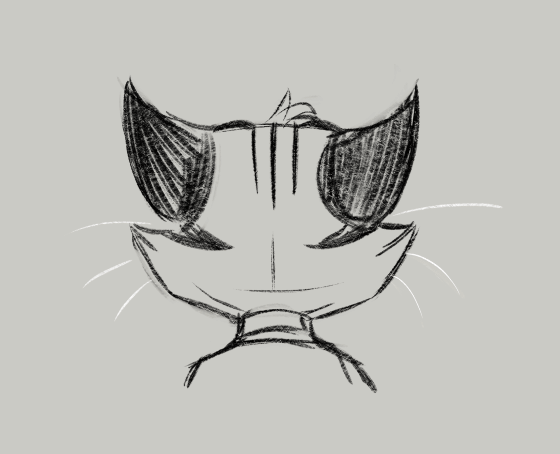
The short film is presented as a pilot, and that is indeed how it plays out: a tour of all the major characters and dynamics of the comic/show, with a car chase, a set piece battle in a quarry, and a final wind down scene in the speakeasy itself which sets up the broader plot. It’s unquestionably very well executed. I’m certain it’s going to get a good few million views in the next few days alone, and maybe it will lead to a series. (Will it surpass Hazbin?). It’s got electro-swing, of course. SungWon Cho (ProzD) is in it, of course.
All the same… I wish it was weirder. Like something about Lackadaisy always feels like it’s playing it safe. It’s fun, it’s goofy, it’s charming… and that’s where it stops! For all that the creators like to talk about how we’re on the cusp of adult animation really taking off in America, the moonshine, and strangely ineffective guns, don’t really change the tone from the more mainstream animation. Bah humbug, etc.
Still, it’s unquestionably an extremely impressive work of animation and a sign of the way things are changing. I expect with all the animation studios laying off staff left right and centre, we’ll start to see a lot more like this.
That’s our first act! For our second…
Ian Hubert returns! I wrote briefly about him back on Animation Night 78. Hubert’s thing is compositing human actors into elaborate cyberpunk environments using Blender; his channel is full of ingenious tricks for creating impressive looking shots and effects with minimal geometry. What makes it work is Hubert’s eye for lighting and composition, knowing just where to place detail to sell a shot and what’s unnecessary for the camera.
The first episode of Dynamo Dream - which we’ll rewatch! - introduced us to a plant selling girl in some sorta cyberpunk megacity. After inadvertently saving out the weird cyborg landlord that runs her apartment, she gets a favour, which she calls on to contact her faraway boyfriend using a kind of missile launched phone terminal I guess? He invites her to come out and join him, but weird shit starts happening on the train. I haven’t watched this yet but I’m sure it’s going to deliver some fascinating visuals.
And then…
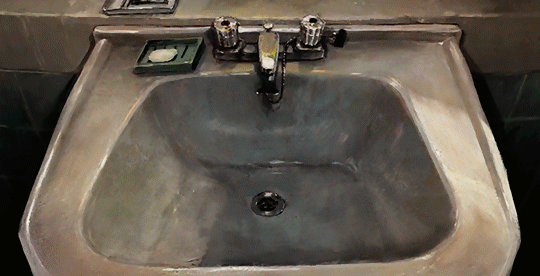
Modest Heroes is a collection of three short films by Studio Ponoc, a studio which spun out of Studio Ghibli. In the mid 2000s, the period that Ghibli could enjoy an exceptional state of employing lot of full-time salaried staff (instead of per project freelancers) was coming to an end. In 2014 it seemed they were on the verge of shutting down altogether. Yoshiaki Nishimura, lead producer of many of Ghibli’s films in the 2000s era (Howl - When Marnie Was There), left the studio in 2015, bringing in a bunch of ex-Ghibli animators under a new studio called Ponoc.
Their first film, Mary and the Witch’s Flower, apparently found it hard to define an identity beyond the shadow of Miyazaki (I haven’t seen it!), but things got a lot more exciting with their second. Modest Heroes is a collection of three short films, showing off a variety of ingenious approaches to animation. (It was originally planned to be four, but then Isao Takahata went and died while planning the segment on the theme of ‘death’… oof.) The writers of Animation Obsessive are big fans, and they’ve written two detailed, enthusiastic articles on two of the shorts in the collection.
Invisible, directed Akihiko Yamashita, is a take on the invisible man concept. Since the invisible man is, well, you know…, his entire existence must be communicated through interactions with objects and clothes. Yamashita hoped to communicate feelings and interior life. His invisibility is a metaphor for social invisibility, and thus it comes combined with other metaphors, such as weightlessness.
The idea came from Nishimura, who thought it was a worthy subject for an ‘animation genius’ such as Yamashita. Nishimura wanted the film to bring a kind of inventiveness that he felt was missing from the overly conservative contemporary anime. Yamashita, after leaving Ghibli, attempted to get by in the regular anime industry and found it unbearably strained. He returned to the fold to work on Boro the Caterpillar with Miyazaki, and this convinced him to follow Yamashita over to Ponoc.
The result is something gorgeous, with its emotional drama playing out against grimy desaturated backgrounds that are perhaps closer to something like Tekkonkinkreet than the Ghibli nature scene. Yamashita named quite a specific palate of inspirations…
As reference, Yamashita drew from Alfonso Cuarón’s Children of Men and Gravity, the films of Alejandro González Iñárritu and the manga of Junji Ito, among others. They contributed to the dark, unusual vibe and look of Invisible.
I’ve been wanting to watch this film for ages, here’s our chance!
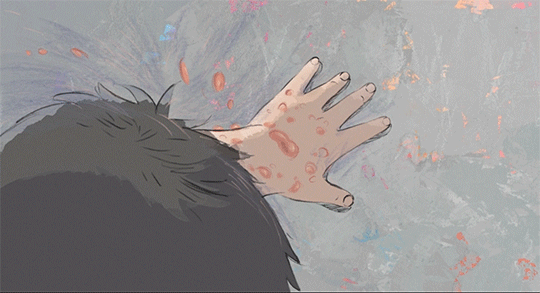
Alongside that comes Yoshiyuki Momose’s film Samurai Egg (here’s the aniobsessive link again). Momose, the ‘right-hand man’ of Takahata, was one of the guys he leaned on to actually draw the storyboards of films like Grave of the Fireflies.
In contrast to the elaborate visual metaphor of Invisible, Samurai Egg is a very grounded film about a kid with a severe egg allergy. Takahata is famed as a realist, although a different sort than people like Okiura and Inoue who bring incredibly meticulous detail and well-observed acting to sci-fi scenarios. Certainly, Takahata would make films about ghosts and mythology, but he’d also make films like Only Yesterday that are much quieter, everyday dramas.
Despite sharing the everyday focus of, this film veers away from it into more expressionistic techniques, bringing in softer pencil effects to the anime cels, as well as techniques like 3DCG-rotoscoping. There’s a dance scene where Shinji Hashimoto gets to go nuts with shapes a la Ryan Woodward.
Momose took some pains to avoid being too sentimental with it; AniObsessive quote Nishimura in Animation Magazine:
When you make a film about a parent and a child, it’s easy to fall into the trap of showing a “heartwarming” relationship, and creating a cheap-feeling structure. We wanted to avoid that.
The film is pre-recorded - like Grave of the Fireflies, actually. (It’s the norm in the West, but rare in anime.) There’s some interesting linguistic nuance there:
It was necessary because Oko’s role called for something special. In a detail that’s lost on foreigners, Shun’s mom uses the Kishiwada dialect, which “sounds harsh, but you can feel the love behind it,” Momose said. It’s a cruder, shorter form of Japanese. They used it partly to fit more information into Samurai Egg’s 16-minute runtime, and partly to reveal the relationship she has with Shun. He’s a Tokyo kid — he speaks differently.
As for the third film…
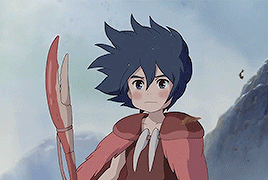
Kanini & Kanino takes us underwater for a pair of kids who live on a coral reef. Alas, I don’t have a detailed article on the making-of and influences on this one, but I can tell you that the director Hiromasa Yonebayishi, aka Maro, is behind it - best known as the director of The Secret World of Arriety, When Marnie Was There, and Ponoc’s first film Mary and the Witch’s Flower. Notably the dialogue for this short is all in ‘crab language’ - are these kids anthro crabs? In fact, yes, it would appear they are anthropomorphic crabs. Sick. Whether they will attend a rave I can’t say, but the internet reliably informs me that is the primary activity of crabs, so probably.
I think that’s enough to be going with! Apologies it’s so late - I had to spend most of today reinventing Canabalt. But I succeeded, so I think I’ve gotten a lot better at this whole game dev thing. Let’s go enjoy some short films!
Animation Night will be going live now at twitch.tv/canmom, films to begin in maybe 15 minutes.
Comments